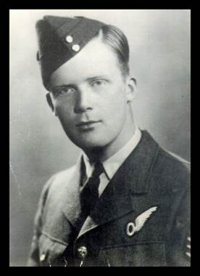Sgt. Joe Hicks and the Battle for Europe
On July 28, 1940, a young Canadian airman named Joe Hicks mailed a picture postcard from a Royal Canadian Air Force school in Regina, Saskatchewan, to a young woman in Fort William, Ontario. Fifty-nine years later, I bought that postcard at an antique store in Quesnel, British Columbia.

The postcard posed several questions: It shows a building identified as the "Royal Canadian Air Force Barracks / Normal School, Regina, Sask." I was curious to know how a public school came to house a military unit — “#2 ITS RCAF” — whatever that was. I wondered whether the writer of the card had a romantic motive when he wrote to the woman in Fort William; his amusing message would indicate that romance was indeed on his mind. And, of course, I wondered if he had survived the war.

Over the course of the next few years, most of Joe’s story — a sad wartime story of love and loss — slowly came to light as researchers in Thunder Bay, Ontario and in Assens, on Fyn Island, Denmark unearthed documents and photographs that revealed some of the dark, early days of the Allied aerial assault on “Fortress Europe,” days that were largely defined by high Allied losses and little damage to German targets. Unfortunately for Joe Hicks and two other members of his Hampden bomber crew, their attack on the German city Rostock on the night of April 24/25, 1942 would end in disaster.
In 2007, I submitted an article about Joe Hicks, titled “Sgt. Joe Hicks’ War,” for publication in Volume XXXVII of Papers & Records, the journal of the Thunder Bay Museum Society. In 2009, that article won the George B. Macgillivray Award for “Most Popular Article” and is available in this PDF, "Sgt. Joe Hicks' War".

Bob Ingraham
Vancouver, British Columbia